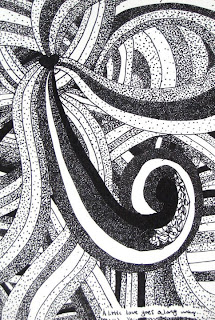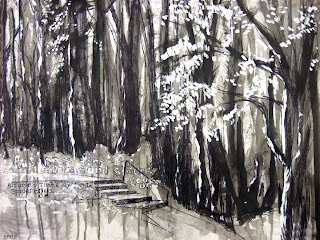 Above is some ink work in Nichole's sketchbook. Below are some busy drawing students.
Above is some ink work in Nichole's sketchbook. Below are some busy drawing students.Saturday, October 31, 2009
Thursday, October 29, 2009
Project No. 5 "non-traditional" ink & ink like - part one
 Remeber to click on images to enlarge them - there are many techniques used in the above artwork - some areas were masked off with, masking tape to protect them while ink was sprayed, washed and rubbed into other areas. "Ah-sticks" were used below to make the stratchy wall surfaces.
Remeber to click on images to enlarge them - there are many techniques used in the above artwork - some areas were masked off with, masking tape to protect them while ink was sprayed, washed and rubbed into other areas. "Ah-sticks" were used below to make the stratchy wall surfaces.
 Above, the wild patterns and swirls made by applying ink on wet paper is partially brought under control with a graceful network of lines. Below is a more tradition drawing done on a rubbed, gray wash.
Above, the wild patterns and swirls made by applying ink on wet paper is partially brought under control with a graceful network of lines. Below is a more tradition drawing done on a rubbed, gray wash.
 Above, much brushwork was used to add the different values of ink. Below, the dark values were added to wet paper. Some talble salt seems to have been used near the bottom to make the dappled effect.
Above, much brushwork was used to add the different values of ink. Below, the dark values were added to wet paper. Some talble salt seems to have been used near the bottom to make the dappled effect.
 Above is the study for the artwork below which incorporates painting values done with diluted ink.
Above is the study for the artwork below which incorporates painting values done with diluted ink.
 Above and below are lots of drips done on wet paper to begin making the forms which were then worked on by drawing tools.
Above and below are lots of drips done on wet paper to begin making the forms which were then worked on by drawing tools.
Project No. 5 "non-traditional" ink & ink like -part two
 Above - controlled painting application of ink watered down to different values. Below - another way to apply ink with a brush.
Above - controlled painting application of ink watered down to different values. Below - another way to apply ink with a brush.Wednesday, October 28, 2009
Odds & Ends
Below are two more "traditional" pen & ink projects.
 Remember to click on images to enlarge them and to see the artists' names.
Remember to click on images to enlarge them and to see the artists' names. Here is an experiment that Steffanie discovered somewhere on the internet. First, a layer of shaving cream was placed in a tin. Next, ink was sprinkled on the shaving cream. Then, a toothpick or similar tool was used to push the ink around. Lastly, a clean paper was pushed into the ink and shaving cream making the "mono print" seen below.
Here is an experiment that Steffanie discovered somewhere on the internet. First, a layer of shaving cream was placed in a tin. Next, ink was sprinkled on the shaving cream. Then, a toothpick or similar tool was used to push the ink around. Lastly, a clean paper was pushed into the ink and shaving cream making the "mono print" seen below.  Next follow a few pages from sketchbooks which we review every Monday at the beginning of class. Dale Witherow, a professor in the art department many, many years ago, told his drawing students that they would need at least 100 sketches in their sketchbooks at the end of the sememster in order to have a chance at an A! Our sketchbooks are filling up and we are now at the halfway point of the semester.
Next follow a few pages from sketchbooks which we review every Monday at the beginning of class. Dale Witherow, a professor in the art department many, many years ago, told his drawing students that they would need at least 100 sketches in their sketchbooks at the end of the sememster in order to have a chance at an A! Our sketchbooks are filling up and we are now at the halfway point of the semester.


 Remember to click on images to enlarge them and to see the artists' names.
Remember to click on images to enlarge them and to see the artists' names. Here is an experiment that Steffanie discovered somewhere on the internet. First, a layer of shaving cream was placed in a tin. Next, ink was sprinkled on the shaving cream. Then, a toothpick or similar tool was used to push the ink around. Lastly, a clean paper was pushed into the ink and shaving cream making the "mono print" seen below.
Here is an experiment that Steffanie discovered somewhere on the internet. First, a layer of shaving cream was placed in a tin. Next, ink was sprinkled on the shaving cream. Then, a toothpick or similar tool was used to push the ink around. Lastly, a clean paper was pushed into the ink and shaving cream making the "mono print" seen below.  Next follow a few pages from sketchbooks which we review every Monday at the beginning of class. Dale Witherow, a professor in the art department many, many years ago, told his drawing students that they would need at least 100 sketches in their sketchbooks at the end of the sememster in order to have a chance at an A! Our sketchbooks are filling up and we are now at the halfway point of the semester.
Next follow a few pages from sketchbooks which we review every Monday at the beginning of class. Dale Witherow, a professor in the art department many, many years ago, told his drawing students that they would need at least 100 sketches in their sketchbooks at the end of the sememster in order to have a chance at an A! Our sketchbooks are filling up and we are now at the halfway point of the semester.


Saturday, October 24, 2009
A few loose ends
James Gurney
 James Gurney gifted us with a poster and information about his new book Imaginative Realism. I am sure the book is full of his special wisdom about painting along with his approach to painting "real" images of things which do not exist.
James Gurney gifted us with a poster and information about his new book Imaginative Realism. I am sure the book is full of his special wisdom about painting along with his approach to painting "real" images of things which do not exist. If you are familar with his dinotopia drawings, you will appreciate the stamps above which Mr. Gurney put on the packet that he sent us.
If you are familar with his dinotopia drawings, you will appreciate the stamps above which Mr. Gurney put on the packet that he sent us.  Thanks!
Thanks!
Wednesday, October 21, 2009
Assignments for Oct. 28, Nov. 4 and Nov. 11
Friday, October 16, 2009
Pen & Ink - handled mostly in a traditional manner
We worked with traditional methods of applying india ink. We developed gray tones by stippling (dots), hatching (parallel lines) and cross-hatching (crossing lines).




















Labels:
intro to drawing,
Mansfield University,
pen and ink
Subscribe to:
Posts (Atom)






















